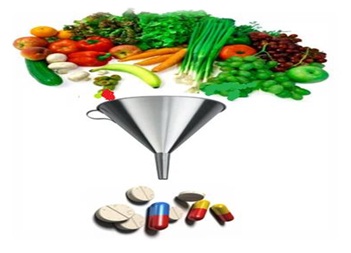The concept of nutraceuticals can be traced way back in 400 BC from the famous quote of Greek physician Hippocrates “let the food be your medicine”. The term Nutraceutical is a portmanteau of the words 'nutrition' and 'pharmaceutical' and was coined by Stephen Defelice, MD, founder and chairman of the Foundation for Innovation in Medicine (FIM) Cranford, New Jersy, in 1989. Nutraceuticals can be defined as foods or its components which provide medicinal or health benefits by playing a significant role in maintenance of normal physiological functions of the body. Currently, nutraceuticals have received considerable attention due to their potential nutritional and therapeutic effects including improved health, slowing down of aging process, prevention of chronic diseases, enhancement of life expectancy and support the structure or function of the body.
People have become more aware about the side-effects commonly associated with the most popular pharmaceuticals. Pharmaceuticals like ciprofloxacin and other fluoroquinolone antibiotics are topoisomerase interrupters means they disrupt the enzymatic process of bacterial DNA replication. Moreover, fluoroquinolones deplete intracellular magnesium. Both enzyme depletion and magnesium depletion lead to mitochondrial dysfunction which further leads to high levels of oxidative stress and that oxidative stress wreaks havoc on multiple health areas. Thus, the demand for nutraceuticals is expected to rise considerably in response to the increasing incidence of non-communicable chronic ailments and the rising healthcare expenditure. Hence, their preference is shifting towards natural food and products derived from natural ingredients, from their synthetically produced counterparts. Furthermore, unlike pharmaceuticals, nutraceuticals are natural healthcare options; they are hence easily available without the need of a prescription. Nevertheless, the most prominent companies are vying to seize opportunities for growth in Asia Pacific. The robust healthcare development in the region has resulted in high demand for nutraceuticals. Additionally, nutraceuticals sales are also expected to rise with their rising application across diverse sectors such as in dentistry, cholesterol reduction, allergy prevention, treatment of inflammatory diseases, and others.
Despite witnessing favourable growth opportunities around the world, the increasing prices of nutraceuticals are hindering their acceptance across less developed economies. Nutraceuticals are generally priced higher than pharmaceuticals. This price gap is compelling people to shift towards low price medicines.The lack of awareness about nutraceuticals is another factor limiting the market’s trajectory. A large section of people around the world are yet to realize the benefits offered by nutraceuticals. A majority of consumers therefore still opt for conventional pharmaceuticals as opposed to nutraceuticals for the purpose of treatment. Common man therefore has less faith in the efficacy of nutraceuticals due to their limited knowledge regarding such products. This adversely impacts the growth trajectory of the nutraceuticals market. A market research recently proposed that the worldwide nutraceuticals market is expanding and would reach US $250 billion by 2018.
The lack of quality control is a major area of concern for nutraceuticals. The quality of plant material and manufacturing processes used for nutraceuticals are regulated by food laws, which lack the specificity required for botanical drugs. This can have serious consequences. Contamination, for instance, with toxins after fungal infection of raw plant material or with other ingredients has been repeatedly reported and can have potential fatal consequences. Adulterations and numerous other types of impurity of nutraceuticals conceivably remain undetected simply because there is an almost total absence of specific quality control. Absence of quality control not only increases the risk to the consumer, it also results in a total lack of impetus to conduct adequate research that demonstrates the potential benefits of nutraceuticals or ensures their safety.
To sum it all, the use of natural compounds is beneficial, powerful and an integral part of a comprehensive healing plan. Proper use is best guided by a physician skilled in functional medicine who understands the intricacies of biochemical interactions. By connecting the many dots revealed through testing, the true needs of the patient can be met. Although nutraceuticals have significant promise in the promotion of human health and disease prevention ,health professional, nutritionists and regulatory toxicologist should strategically work together to plan appropriate regulation to provide the ultimate health and therapeutic benefit to mankind. Long-term clinical studies are required to scientifically validate the nutraceuticals in various medical conditions. The interaction of nutraceuticals with food and drugs is another area, which should be taken into consideration. The effect of different processing methods on the biological availability and effectiveness of nutraceuticals remains to be determined. As like drugs, there should be strict regulatory controls for nutraceuticals.
Classification of nutraceuticals
|
Class |
Components |
Sources |
|
Terpenoids |
Carotenoids, Tocopherols, Terpenes, Saponins, cannabinoids, ginkgolide, bilobalide, curcuminoids |
Tomato, carrot, beet root, Ginkgo biloba, turmeric, |
|
Phenolic compounds |
Flavonols, Isoflavones, Lignin, Anthocyanins |
Blueberry, raspberry, black carrot, muscadine grape, red cabbage, spirulina. |
|
Fatty acids and lipids |
Omega-3, alpha lipolic acid. Monounsaturated fatty acids (MUFA), Polyunsaturated fatty acids (PUFA), conjugated linoleic acid |
Flaxseeds, canola oil, walnuts, chia Seeds, fish oil |
|
Minerals |
Calcium, Iron, Selenium, Potassium, Manganese, Zinc, phosphorus |
Milk, green leafy vegetables |
|
Microbials |
Probiotics, Prebiotics |
Beneficial bacteria and enzymes |
